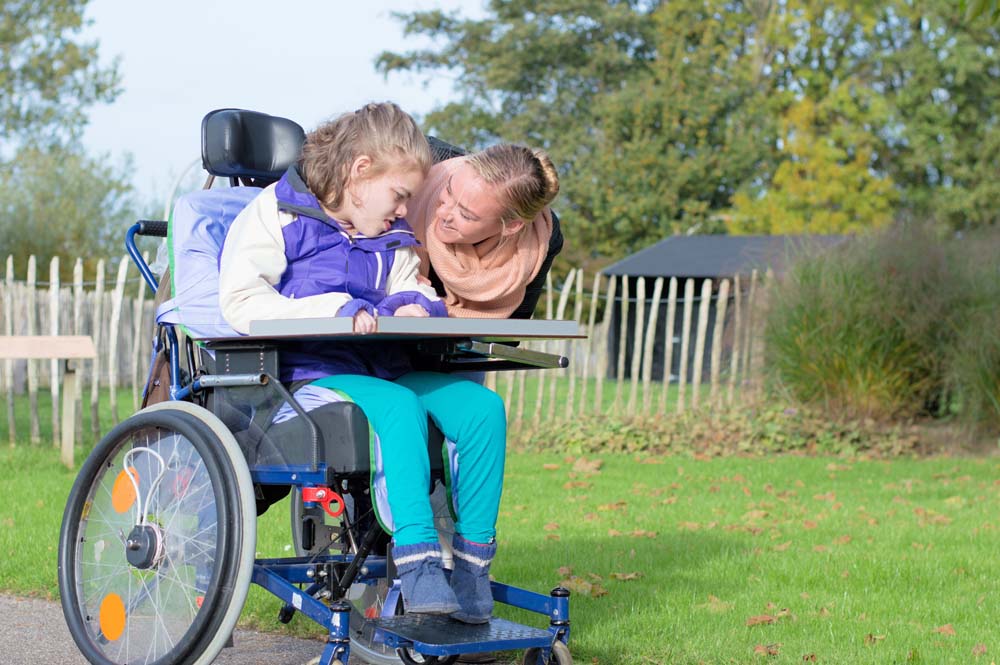Communication Disabilities
Communication disabilities can affect a child’s ability to receive, send, process, and understand verbal and other communication. By first grade, an estimated 5% of children have noticeable speech disorders.
(Adapted from American Speech Language Hearing Association & American Psychiatric Association, 2013.)
- A speech therapist works with a child with a communication disability
What You Might Notice
Some children may have a stutter or difficulties with putting their thoughts into words, while others may have difficulty using language to engage with people.
Children with a speaking disability might be difficult to understand at first, but spending time together will make speech easier to understand.
Some children with complex disabilities, such as autism spectrum disorder, cerebral palsy, or traumatic brain injury, also have difficulty with speech and comprehension.
Communication aids may include:
- a simple paper tablet or white board to write on
- for children who cannot read, a customized picture board or picture notebook with pictures of food, people, activities, clothing, places
- boards with frequently used words, which allows children to communicate quickly
- an electronic device that matches the child’s ability to read and write and provides voiced communication
Before Meeting the Child
Find out specifics about the child’s communication disability. Does the child have difficulty understanding what is being said, producing speech or sound, or a combination of several areas? How does the child best communicate, and what communication aids do they use?
If the child uses a communication device, check with a safe family member, caregiver, or speech therapist to make sure the device includes the language or symbols necessary to disclose abuse. Ask the speech therapist or family member to program in words the child might need, including the child’s words for body parts, and words for violent actions, such as kicking or hitting.
If English is not the child’s primary language, arrange for a qualified, licensed interpreter (e.g., American Sign Language, Spanish, or other language).
Ask about other disabilities that might affect the interview.
During the Meeting
Begin by assuming you will be able to understand each other. The child may very well be able to understand and process what you are saying, and with some trial and error you may be able to understand the child’s speech.
Avoid assumptions. A child who has difficulty communicating may understand everything you say and be very bright.
If the child uses a speaking device, become comfortable with communicating through it before actually beginning with crucial aspects of the interview.
Set the Stage
Speak normally. Look directly at the child, not at others who are providing assistance.
Allow for silence, and avoid the temptation to fill in the blanks.
Acknowledge challenges in the beginning of the interview by saying: "Sometimes it is hard for me to understand what new people are saying. I may ask you to repeat things." Or: "I have to learn what words you use for different things. I may ask you to make drawings to help me understand what happened." (Oregon Department of Justice, p. 29).
The less stressful and hectic the setting, the more easily children will be able to communicate.
In addition:
- Become familiar with what the child’s behaviors, sounds, or movements mean in response to your questions.
- Listen carefully to what words the child uses and what those words mean to him. Clarify: "When you say, 'She jumped you', what do you mean?”
- Repeat back what the child said.
- If the process is frustrating the child or no progress is being made, consider calling in a support person who knows the child but has no investment in the outcome, such as a teacher, speech therapist, or interpreter. If the teacher or speech therapist is the person who reported the abuse or neglect, select another person who can understand the child’s speech.
- Unless the child requires someone to interpret, do not allow a third party to speak for him/her.
(Adapted in part from Hoffman-Rosenfield, 2004; & Oregon Department of Justice.)
Set the Pace
Be prepared to slow the pace, and allow extra time for communication. Offer breaks. Some children’s speech may become more slurred when they are stressed or tired.
Wait after asking a question. Repeat what you hear to clarify the meaning.
Communication
If the child has difficulty communicating by speaking, writing, or sign language, they can still indicate yes or no with a tapping pencil, or by nodding, blinking eyes, thumbs up, thumbs down.
If the child is unable to speak or use a communication device, the interviewer may need to do all of the speaking. Even so, yes/no questions do not have to be leading. You may rely on drawings, pictures, and anatomically correct dolls. (Use these according to the standards set by the American Professional Society of the Abuse of Children.)
Note: For investigative purposes, this method of communication would need to be documented before starting the interview.
If You Do Not Understand
Do not pretend to understand if you don’t. Be honest, and ask the child to repeat.
If you are still having consistent difficulty understanding:
- Wait: Decoding speech patterns can take a little time. Listen to the whole sentence or phrase. Become comfortable with some wait time. Let the context help you.
- Repeat: Asking the child to repeat the sentence may be enough. However, the child may not be able to change how they pronounce a specific word. In that case, move on to another strategy.
- Rephrase: Ask the child to try and express the same thought using different words. Often, the misunderstanding hinges on one or two words in a sentence.
- Identify which part of the sentence or thought you do not understand. You might try repeating the part you understand, and ask the child to focus on repeating the part you did not get.
Finally, if none of the above efforts work, if the child can spell, ask them to spell it out for you. It usually just takes the first few letters of the word to clear up the confusion. Alternately, you can ask the child to write it down, or you can write down what you thought they said, and can give each other feedback.
If the Child Does Not Understand
If the child has difficulty understanding what is being said or written, minimize distractions. Use short sentences and express one thought at a time.
Again, allow for long silences if needed, and stop regularly to ask if the child has questions. Pay attention to eye contact, body language, and other cues that the child does not understand.
Interpreters
Familiarize yourself with the ethics of working with an interpreter, as well as the legally required standards and level of certification.
Be prepared for your agency to cover the costs of interpreter services, as needed.
Be sure the interpreter is present before starting the interview, is familiar with and can operate the communication system used by the child, and that all parties and devices are positioned in the room for clear communication.
Always speak to the child, not the interpreter.
Sometimes, only the teacher, speech pathologist, or the care provider will be able to understand the child’s communication.
Avoid using a parent or family member to facilitate communication, as that person may be the abuser, may collude with the abuser, or may have other reasons for not providing an accurate interpretation.
A Caution About Communication Devices
An abuser may withhold or break communication devices in an attempt to silence the child. In addition, some abusers may attempt to “speak for” the child or refuse to program communication devices to further prevent disclosure.
When interacting with the child who may use these types of communication supports, be aware of this dynamic and include it in any safety planning that you may offer.
(The above sections adapted in part from Chadwick Center for Children and Families; Hoffman-Rosenfeld, 2004; New York State Office of Child and Family Services; Office for Victims of Crime; Oregon Department of Justice; and SAFE.)



